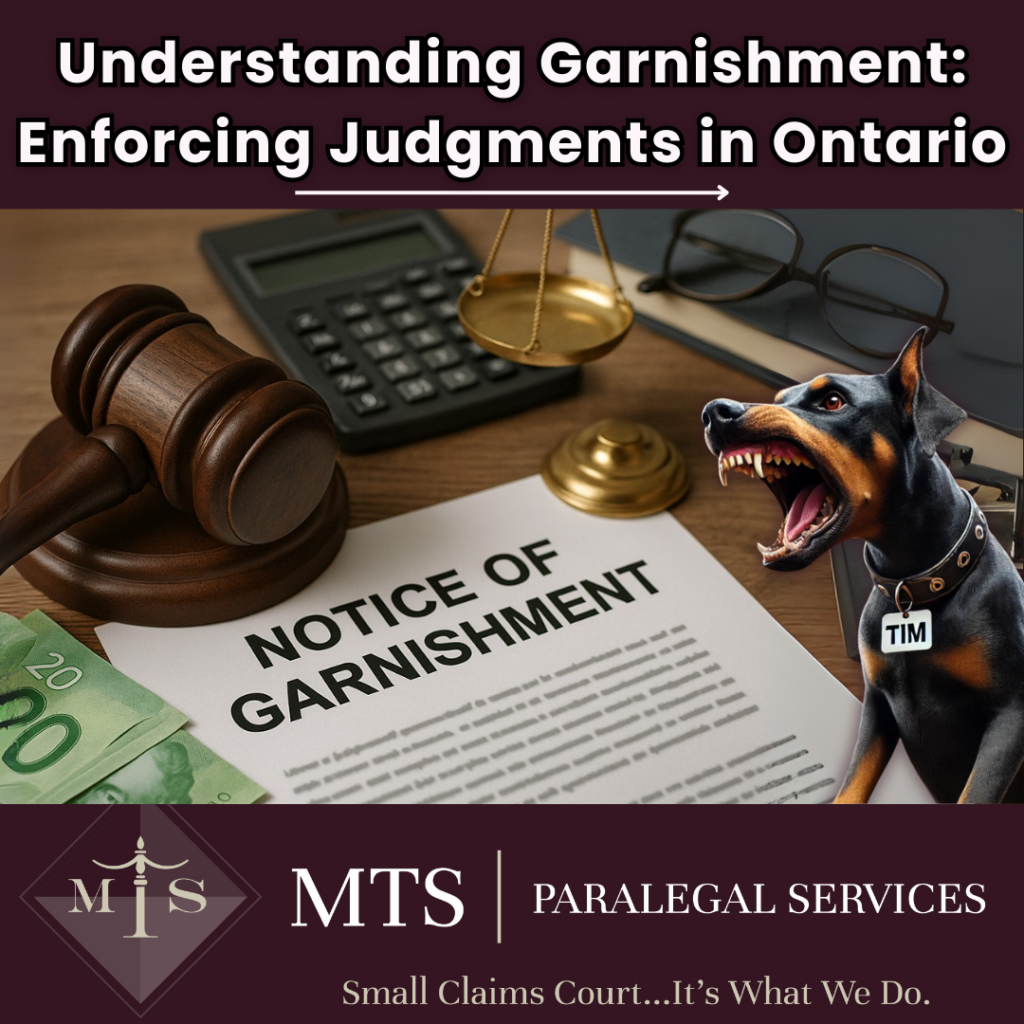
Understanding Garnishment: Enforcing Judgments in Ontario
Understanding Garnishment in the Ontario Legal System
In Ontario, obtaining a judgment in Small Claims Court or the Superior Court of Justice does not always guarantee voluntary payment by the debtor. Creditors often find themselves in the position of needing to enforce their judgment through statutory mechanisms. One of the most effective enforcement tools available under Ontario law is garnishment. Garnishment allows a creditor to intercept funds owed to the debtor by a third party, ensuring that a valid court judgment is honoured.
MTS Paralegal Services, located at 15 Schneider Avenue, A2 Kitchener, Ontario, N2G 1K7, provides professional representation in matters involving judgment enforcement, including garnishments. Tim at MTS assists clients in navigating this complex area of civil enforcement to recover monies lawfully owed.
The Legal Foundation of Garnishment
Garnishment is governed primarily by the Rules of the Small Claims Court and the Courts of Justice Act. Once a judgment is obtained, a creditor may bring a motion or application for a garnishment order. The creditor must file the necessary documents, including a Notice of Garnishment, to lawfully compel a third party (known as the garnishee) to remit funds owed to the debtor.
Common garnishees include employers, financial institutions, or other parties who owe money to the debtor. Once served, the garnishee is legally obligated to pay a portion of the debtor’s funds directly into court, which are then distributed to the creditor.
Types of Garnishments
There are generally two common categories of garnishment in Ontario:
- Wage Garnishment – This type of garnishment compels an employer to deduct a portion of the debtor’s wages. By law, up to 20 per cent of the debtor’s wages may be garnished, although certain exceptions and protections apply under the Employment Standards Act and federal legislation.
- Bank Account Garnishment – A financial institution may be ordered to remit funds held in a debtor’s account. Unlike wage garnishment, there is no statutory percentage limit. However, practical challenges may arise if accounts contain minimal balances or are held jointly.
Both forms of garnishment require strict compliance with statutory procedure. Errors in filing or serving documents may delay recovery and increase costs for the creditor.
Rights and Protections for Debtors
Although garnishment serves the legitimate purpose of debt enforcement, the law balances creditor rights with debtor protections. For example, debtors who can demonstrate undue hardship may bring a motion to vary or suspend a garnishment order. Similarly, certain types of income, such as social assistance or Employment Insurance benefits, are exempt from garnishment under federal and provincial law.
These protections ensure that garnishment does not leave a debtor destitute or unable to meet basic living expenses. Creditors must therefore ensure that their enforcement efforts respect statutory exemptions, as failure to do so may result in judicial intervention.
The Garnishment Procedure
The process of garnishment in Ontario typically involves several steps:
- Obtain a Judgment – Garnishment cannot proceed without a valid court judgment or enforceable order.
- File a Notice of Garnishment – This document must be filed with the appropriate court office.
- Serve the Garnishee and Debtor – The garnishee and debtor must be formally served with the Notice of Garnishment.
- Payment into Court – The garnishee pays the required funds into court as directed.
- Distribution of Funds – The court distributes the funds to the creditor, less any applicable fees.
Strict adherence to timelines and procedural rules is critical to avoid dismissal or unnecessary delay. Professional representation by a licensed paralegal such as Tim at MTS can ensure that each step is executed accurately and efficiently.
Strategic Considerations for Creditors
Not every debtor is an ideal candidate for garnishment. A creditor should first determine whether the debtor is employed or maintains funds in a bank account. Conducting a judgment debtor examination may assist in uncovering assets or employment details. In addition, creditors should weigh the costs of pursuing garnishment against the likelihood of recovery.
For instance, if a debtor has irregular employment or receives income exempt from garnishment, other enforcement mechanisms—such as a writ of seizure and sale of personal property—may be more effective. A tailored strategy, guided by professional legal advice, ensures the creditor maximises recovery while minimising wasted resources.
Assistance from MTS Paralegal Services
Enforcing a judgment can be challenging without a clear understanding of Ontario’s enforcement laws and procedures. Tim at MTS Paralegal Services provides tailored guidance in garnishment matters, including the preparation, filing, and service of documents. With professional representation, creditors can improve their chances of recovering amounts lawfully owed.
To discuss judgment enforcement or garnishment proceedings, contact Tim at MTS Paralegal Services. Visit mtsparalegalservices.com or call (226) 444-4882. MTS Paralegal Services—Small claims court, it’s what we do.
This content does not constitute legal advice. For up-to-date guidance or legal advice specific to your situation, please contact MTS Paralegal Services or call (226) 444-4882.
